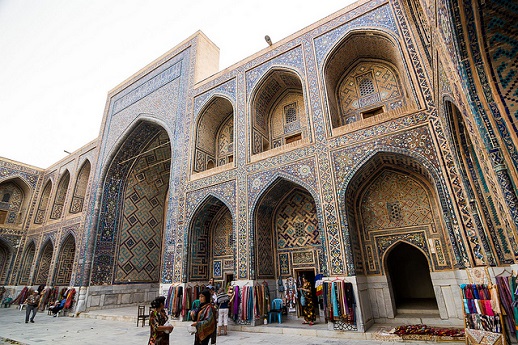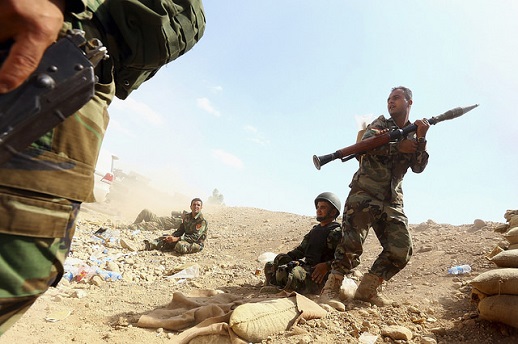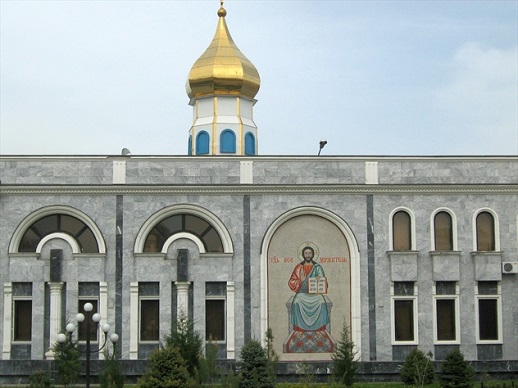When the three suicide bombers who killed 44 people at Istanbul’s main airport on 28 June were identified as Russian, Uzbek and Kyrgyz nationals, it provided another reminder that the threat from the so-called Islamic State reaches far beyond Syria and Iraq.
And nowhere is that threat being taken more seriously than in the Central Asian countries of Uzbekistan, Kyrgyzstan, Kazakhstan, Tajikistan and Turkmenistan, according to a new report from Open Doors International, a charity that supports Christians under pressure for their faith.
The report, written by consultant risk analyst Mark McNamee, suggests the dictatorial regimes of the five Central Asian states are fully aware of the threat and will do whatever it takes to quash it – which, McNamee says, means “repression and control” of every citizen, regardless of their religion, or lack thereof.
But how significant is this threat? And how does it affect the region’s Christian minority? World Watch Monitor summarises McNamee’s conclusions:
1. Control is key
McNamee says the “first and effectively only priority of these governments is the survival of their regime, with national security a secondary but contributing priority”.
“Ultimately,” he writes, “these regimes are deeply insecure and are fanatically consumed by the need to control and eliminate any potential threat to their survival.”
2. Islam seen as threat
“Central Asian states have seized upon the counterterror narrative to justify blanket repression,” he says.
“The tide of global terror … gives these governments the necessary cover to continue their repression now under the premise of internationally justified means.
“Any non-government sanctioned Islamic activity or movement … is demonized and strictly suppressed.
“Those countries that view the threat as more internal … tend to be even more repressive of their population. [If] external, the government response tends to be concerned more with keeping out external forces that could radicalize their population or conduct terror operations within their territory.”

3. But how significant is that threat?
“In reality,” writes McNamee, “there is truly very little threat of radicalism due to the success of secularism across the entire region over the past five centuries, despite a recent resurgence in piety since the collapse of the Soviet system.
“While Salafi [hardline] clerics have always been present, Salafism as a movement has never played a prominent role in forming the belief system of the population or clerics.”
Instead, McNamee says the majority of Central Asian Muslims adhere to “the more liberal” Hanafi school of Islam … “These Hanafi leaders, who wilfully acknowledge the state’s supremacy, now constitute the approved Islamic leadership in each Central Asian state,” he writes.
“Moreover, the clearly increased religious piety since the fall of communism has not translated into more radical versions of Islam and violence.”
However, McNamee acknowledges that hundreds of Central Asians have joined the so-called Islamic State, and that “these states have felt increasingly insecure in light of the departure of Western forces from [neighbouring] Afghanistan and, primarily, from the rise of Islamic State and the potential for the spread of its ideology and violence into Central Asia.”
Yet he points to the “lack of a significant presence of Islamic violent organizations in the region, currently or historically” as “further proof of the inaccuracy of these government’s claims of burgeoning violent Islamist activity”.
4. How many Central Asians have joined IS?
McNamee says the figures are inexact, but that the best independent estimates are as follows:
Tajikistan – 160 – (though the government says between 200 and 300, while a Tajik fighter claims there are 2,000 and 500 have been killed.)
Uzbekistan – 500
Kyrgyzstan – 100 – (although “likely exaggerated” data from law enforcement agencies says 230).
Kazakhstan – 250 – (though the government claimed in 2014 that 300 had joined, half of them women).
Turkmenistan – 360 – (a “comparatively significant number” given that “Turkmenistan is unique in the region in that it has not suffered a terror attack linked to Islam, nor has there been an internal Islamist movement”.)

5. Fears over fighters returning
“Any threats arising from IS or Afghanistan linked in any way to a Central Asian state is interpreted by the regimes as a potential threat to all the countries, creating a heightened and more tense security environment with ostensible threats abounding,” writes McNamee.
But, he notes that “a high proportion of these militants end up either dead or disillusioned, remain in the region, move to another battlefield, or are arrested by authorities upon re-entry, the last of which is more of a reality in light of the greater focus on security and improved counterterrorism forces in Central Asia (yet major issues with regard to porous borders and corrupt law enforcement clearly continue). Certainly, many of these militants will attempt to return with their experience, weapons, and radical ideologies and this threat needs to be taken seriously”.
6. But is there a greater threat for Central Asia?
“Despite warnings for years of the potential for extremism to result from repression, none of this has come to fruition,” McNamee writes.
He cites an academic’s prediction after 9/11 that “repression … and the impossibility of political expression” would “naturally radicalize the population and assuredly drive them over time to join extremist groups”. “Clearly, this prediction has not materialized,” he says.
Instead, he suggests a new threat to the regimes: that of forecasted economic instability and “looming succession crises in nearly all these regimes”.
“The coming several years do indeed appear to be ushering in a new and possibly unstable political and economic era,” he says. “In light of the coming difficult years ahead within Central Asia, it is particularly worrisome to add [radical] groups and ideologies to the mix.”
7. Implications for Christians
“Whether all this translates in the future into increased threats to Christians from the government and the Islamic society remains to be seen,” McNamee writes.
“Rising Islamic identity and its resulting potential for persecuting Christians is in part a by-product of the repression and general poor governance of these governments.
“The real threat to Christians emanating from this state/Islam dynamic is a strengthening of the Islamic identity, which in turn would increasingly view Christians in a hostile light.
“Each of these countries have experienced some level of Islamization evidenced by either the internal development of Islamization or by the number of individuals who have gone to fight in Afghanistan/Pakistan or Iraq/Syria.”
But, he says, “In each of the five Central Asian countries, the primary driver of persecution against Christians remains the authoritarian government, the difference being merely in intensity.”
However, McNamee doesn’t address the potential for Christians to suffer the adverse effects of stringent rules and regulations – and arrests and detentions – brought in to repress Islam but also affecting the Christian minority.
Indeed, one commentator, who did not wish to be named, told World Watch Monitor Christians can be targeted so that Muslims cannot claim they alone are being harshly treated.

Country specifics
McNamee evaluates each country in turn. His key points:
1. Tajikistan
“The Central Asian nation most commonly deemed to be under threat from Islamism due to the fragility of the state, its geographical proximity to (and historic involvement in) Afghanistan, the relatively high participation of Tajiks in IS, and the homegrown religious element in the bloody civil war of the 1990s.
“This history serves as validation of the potential of radical Islam and the required government repression to combat it. Aside from validating repression, the government also gains continued financial and armaments support from Russia.”
2. Uzbekistan
“To an even greater extent than its neighbours, Uzbekistan effectively whitewashes all distinctions of Islamic activity not government sanctioned as radical and terrorist.
“The Karimov regime is particularly paranoid and security-minded due to the large potential for unrest on account of the comparative large size in Central Asia (accounting for roughly half the population of the area), greater ethnic diversity, and the independent development of jihad within its territory.
“Uzbekistan’s Islamists in the 1990s saw in the Tajik Civil War an opportunity for jihad and participated in that war aligned with the Islamic Renaissance Party of Tajikistan, as they were powerless to struggle for Islam in their own country. In the aftermath, [they] rejuvenated themselves in the Ferghana Valley of Uzbekistan, from whence sprang the Islamic Movement of Uzbekistan and Hizb ut-Tahrir, both of which have officially sought the overthrow of the Karimov regime to be replaced by a caliphate. Both groups have effectively been extinguished in the region, with IMU regrouping in northern Afghanistan and the Afghanistan/Pakistan border region and most recently subsuming itself to IS.”
3. Kyrgyzstan
“The threat of Islamization in Kyrgyzstan is significantly weaker … Nevertheless the government has taken a notably harsh stance.
“To a greater extent than most of its neighbours, Kyrgyzstan views the threat from Islamism almost exclusively as external, with the overriding fear being that of militants from Afghanistan/Pakistan and Iraq/Syria returning.
“The regime further recognizes the underlying weakness within Kyrgyz society – its high poverty levels, poor economic growth, weakness of the state, etc. – as proving the latent potential for an Islamist movement to gain traction.
“The irony is that through repressing its population in such an indiscriminate and arbitrary manner, the country may be generating a domestic threat of greater Islamization that had not been there previously.”
4. Kazakhstan
“The history of political Islam in Kazakhstan is minimal and even an apparent string of possibly Islamist-inspired terror attacks earlier in this decade have proved to be an aberration.
“Prior to 2015, the Islamist threat was seen as stemming from the extended Central Asian region. More recently, the concern has shifted from the spillover from Afghanistan to Kazakh militants active in IS.
“The government’s attitude towards Islam will likely become increasingly conservative and reactionary in light of the recognized coming economic downturn and its potential social and political repercussions. Kazakhstan will struggle from massively declining growth in 2015 and the next several years, which the government fears could evoke anti-government sentiment among the people, including a possible gravitation towards Islamism. The mere threat of this will likely encourage the government to be proactive on the matter via greater repression against any signs of potentially destabilizing religious activity.”
5. Turkmenistan
“Turkmenistan is unique in the region in that it has not suffered a terror attack linked to Islam, nor has there been an internal Islamist movement.
“Thus, the threat of Islam is viewed by the government primarily as being a foreign phenomenon that could destabilize the country, not via an enduring ideological movement that gains local support.
“Turkmenistan rivals Uzbekistan in terms of general repression and specifically with regard to any non-sanctioned Islamic activity. Effectively all religious behaviour is controlled and Turkmen worship nearly exclusively in government built and controlled mosques.
“The controlling nature of the government is perhaps best seen in the fact that former President Niyazov, notorious for his authoritarianism, in essence created his own Qur’an (the Ruhnama) to be used as spiritual guidance.”